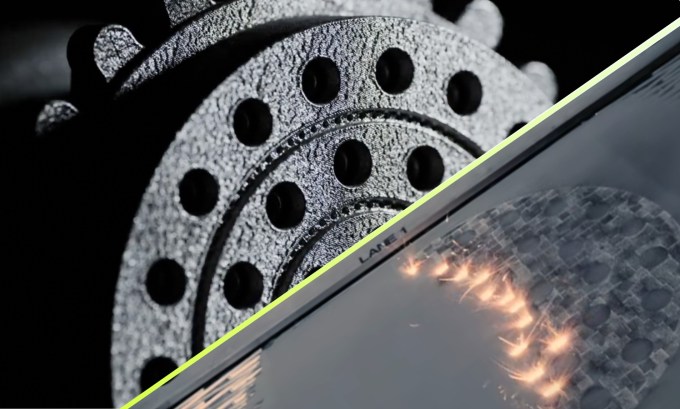3D printing objects using metal is a well-established technique, but it tends to be too complex, expensive, or imprecise to match traditional methods at scale. Armed with $14 million from Nvidia and Boeing, Freeform aims to change that by building a new metal additive printing process that it says changes the game — and yes, there’s an AI angle, too.
Co-founders Erik Palitsch (CEO) and TJ Ronacher (president) both worked at SpaceX, where they were principal architect and lead analyst, respectively, of the Merlin engines and other programs. While there, they saw the potential of 3D printing parts using metal, but also experienced the method’s shortcomings firsthand.
“We saw the potential of metal printing; it has the potential to transform basically any industry that makes metal things. But adoption has been slow and success has been marginal at best,” said Palitsch. “Why is it not practical to use at scale? Fundamentally, because of three things: crappy and inconsistent quality; speed — commercial printers are very slow; and cost — the price for these printers is astronomical.”
They concluded that if they could operationalize the process to provide a printing service rather than sell a printer, they could crack the whole thing wide open. So they joined up with Tasso Lappas, former CTO of Velo3D, to start Freeform.
The primary mistake companies were making was using the likes of CNC machines, which are commonly used in traditional manufacturing, as a model for the metal-printing business. In that case, you sell the machine and its software, and make it work with whatever shapes and processes you use. But metal additive is different, Palitsch said.
“The way these things work today is they’re ‘open loop’ — they’re basically playing back a file,” he explained. “They needed to be smarter than that, because the process by which you melt metal powder with a laser is extremely complicated, and in a way infinitely variable.”
Selling people a machine and saying “become an expert to make it work, good luck,” isn’t a recipe for success.
“But when you decide you’re not going to build and package a printer into a box, when you have the freedom to build an automated factory from clean sheet, there’s a lot you can do,” Palitsch said.

Their solution is to provide printing as a service using a closed-loop process in a custom machine that monitors the print on a microsecond scale, adjusting various factors to achieve the kind of print that is expected at a workplace like SpaceX.
The company has plenty of tech advances to boast of, but the two most immediately relevant are the feedback loop and the AI that manages it.
“We have high-speed computer vision feedback on our system that runs at microsecond scale, and all that data is being processed on state of the art FPGAs and GPUs. We had to build this whole stack ourselves out of stuff that’s only become available in the last few years,” said Palitsch.
The closed-loop system with real-time monitoring mitigates the quality issues while still allowing speedy printing of complex geometries. And by operating as a printing service, they keep the business model simple.
But making that part of the system work required the second tech breakthrough: a machine-learning model fast enough and expert enough to actually perform that monitoring.

“Erik and TJ lived this and reached the same conclusions, that this industry required a level of compute and sensors that no one had ever deployed before,” said Lappas.
“To properly understand how to control the process, we needed datasets working at timescales that no one had. So we started building a state of the art telemetry system, a platform that would collect curated, controlled, almost self-labeled datasets.”
This data allowed them to bootstrap a model to generate more data for a better model, and so on.
But then they ran into the necessity of speed.
“There’s a lot we have in common with generative models, and a lot we don’t. But one thing that’s absolutely different is the latency,” Lappas explained. “Our inference needs to happen in microseconds so that we can close the loop on these processes.” With no off-the-shelf solution available for the data or the compute, they had to build the GPU/FPGA “AI on steroids” combo from scratch.
A consequential side effect: Freeform is “building the largest metal additive dataset in the world — that’s why companies like Boeing are coming to us,” said Palitsch. “We have this fundamental, core data collection and processing ability no one else has.”
Add that to the fundamental benefits of printing-based manufacturing, like the agility and versatility of factories, and it makes a pretty compelling business case.
Boeing’s AE Ventures and Nvidia invested a total of $14 million, though they declined to break that down further. Each company’s investment comes with perks: Nvidia gives them access to H100s and other compute hardware, while Boeing will shepherd them through the supplier qualification process and likely buy a bunch of parts. (Freeform will also join Nvidia’s Inception startup program.)
Palitsch said they have customers in the aerospace, automotive, industrial, and energy sectors, “the whole nine.” They declined to put any on the record, but did mention they’re making everything from rocket engine components to exhaust parts for Formula 1 cars. They plan to use the money to scale up, build out their next generation of (much faster) printers, and hire up to around 55 people total over the next year.
He admitted that their approach has taken time to grow from theory to reality, but that their methodical, technical approach is also what enabled their success.
“It was a slow transition,” Palitch said. “But I look back at it… with six people, we built, from scratch, the fastest laser melting platform on the planet, and the hardware and software for it. We did things people said you couldn’t do.”





Leave a Reply